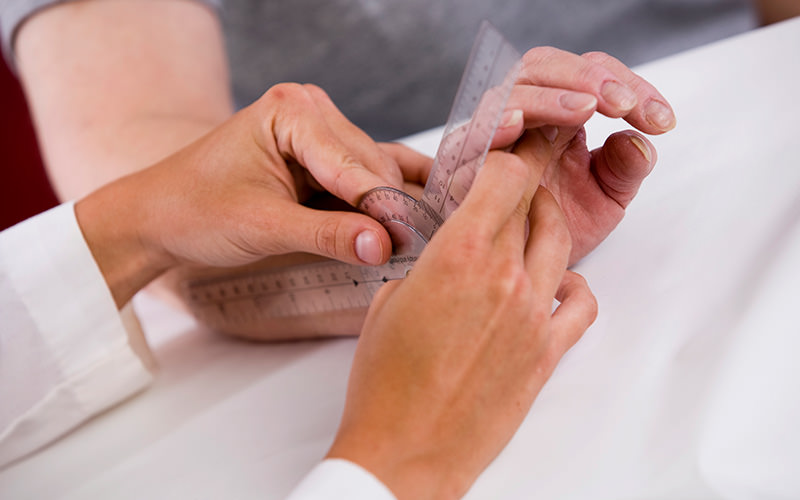
If you’re experiencing hand, wrist or elbow pain, you may need to see a hand therapist. Just like regular physical therapy, hand therapy can help you regain strength, flexibility and range of motion in your fingers, hands, wrists and arms after an injury, such as broken bones. You may need hand therapy after surgery, or your provider may recommend it to help manage a chronic condition, such as carpal tunnel syndrome. Summit Orthopedics provides advanced hand therapy treatment to patients of all ages across the greater Minneapolis/St. Paul area.
About Hand Therapists
What is a hand therapist?
Hand therapists are licensed physical or occupational therapists who have received advanced training in treating conditions that affect the upper extremities. All hand therapists at Summit Orthopedics have significant clinical experience and are proficient in treating pain, trauma, injury, disease and congenital deformities of the hand and arm. Hand therapists integrate their knowledge of anatomy, physiology and kinesiology to create treatment plans to improve or restore function.
What credentials does a hand therapist have?
All hand therapists are credentialed professionals, but the type of training each has can vary. An occupational therapist (OT) will have a designation of OTR (Occupational Therapist Registered), which means they have passed a national licensure exam after extensive education and training. An OTR/L has additional state certification (the “L”). Many hand therapists also have the designation of OTD (Occupational Therapist Doctorate) because they have a doctorate degree in their field.
A physical therapist (PT) has finished an accredited bachelor’s-level education and training and passed a licensure exam. An MPT has a master’s degree in physical therapy, while a DPT has a clinical doctoral degree.
A certified hand therapist (CHT) is an OT or PT who has additional training—three years of experience as a therapist, plus an additional 4,000 hours of hand therapy practice. All OTs, PTs and CHTs must attend frequent continuing education seminars to stay up to date on new research and education.
Do hand therapists only care for the hand?
Hand therapists treat problems affecting both the hand and arm, including the fingers, wrist, elbow and shoulder. Muscles, tendons and ligaments in the forearm and upper arm help coordinate and control motion in the hand, wrist and fingers. Hand therapy helps ensure optimal range of motion, strength and stabilization during movement in most daily activities.
About Hand Therapy
What happens in hand therapy?
Hand therapy will be different for every patient. Some people may need to relearn how to use their hands after a stroke or car accident. Others with arthritis or carpal tunnel pain may find pain relief with hand therapy. Some patients may benefit from hand therapy after a sports injury so they can get back to the game.
What types of treatment do hand therapists use?
Hand therapists use a wide range of therapeutic interventions to treat different problems, including:
- Bracing, slings and other adaptive equipment or devices
- Compression wraps and other tools to manage swelling (edema)
- Physical modalities, such as electric current, fluidotherapy, heat, ice, paraffin wax and ultrasound
- Scar treatment
- Strengthening and stretching exercises
- Wound care
Do hand therapists perform manual therapy?
Manual therapy is a physical therapy technique in which your therapist manually adjusts, manipulates or puts pressure on your body, either with their hands or with a tool. Several manual therapy techniques are used in hand therapy, including:
- Graston or gua sha (tool-assisted soft tissue mobilization)
- Joint mobilization
- Manual edema mobilization
- Myofascial release
- Soft tissue mobilization
Manual therapy may help improve scarring, swelling, muscle imbalances and pain.
How often do I need hand therapy?
How frequently you see your hand therapist will depend on your condition and the cause of it.
Most people receiving hand therapy will learn simple exercises to practice at home. Doing these exercises daily (or as frequently as your therapist tells you to) is an important part of your therapy, even if you aren’t in a hand therapy location.
How to Get the Most Out of Hand Therapy
Why should I get hand therapy?
Hand therapy has many advantages for your health, such as:
- Decreased medical costs
- Faster recovery
- Improved function
- Pain management with fewer medications
- Quicker return to work or other activities
Should I make lifestyle changes after hand therapy?
Depending on the cause of your hand or arm pain, your hand therapist may make ergonomic recommendations to help relieve or prevent problems. These recommendations could include:
- Changing your workspace to better fit your body
- Wearing a brace or other protective equipment while working
- Using different equipment to relieve stress on your upper limbs, such as specially designed tools or dictation software
Patient education on how to modify your activities and work is often an important part of hand therapy.
What if I have more questions?
Your Summit Orthopedics hand therapist is here to help you. If you aren’t clear on how an exercise works or why we are asking you to do something, just ask. We are glad to explain everything we do and the anatomy behind it. Our goal is to get you back to using your hands and arms the way you want to—at work, at home and everywhere in between.
Discover how Summit Orthopedics hand therapy can help you. Schedule an appointment.
